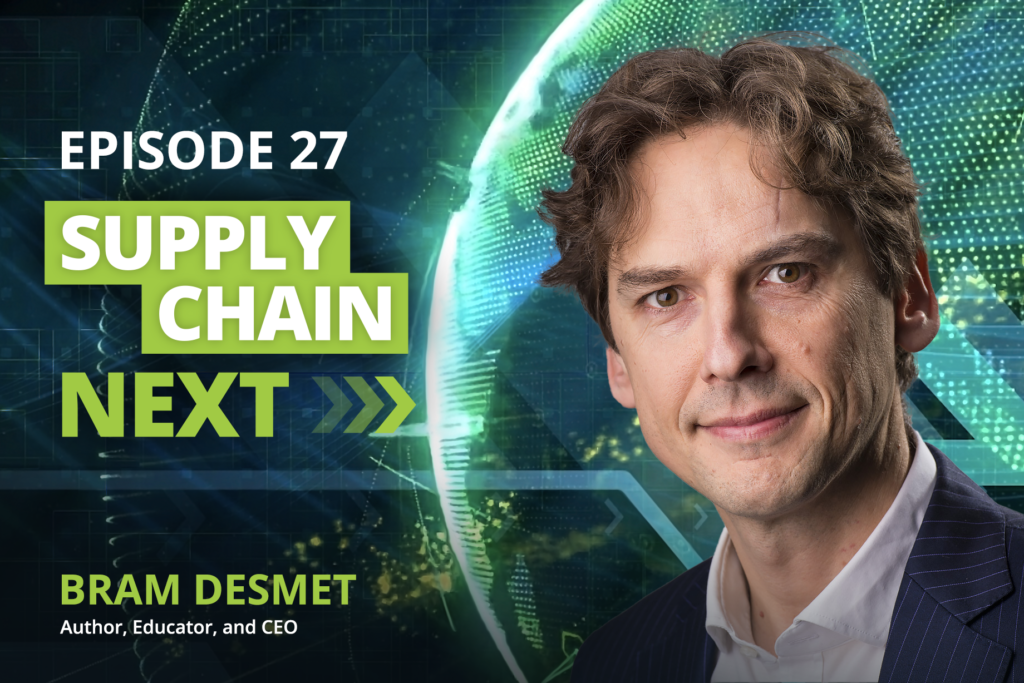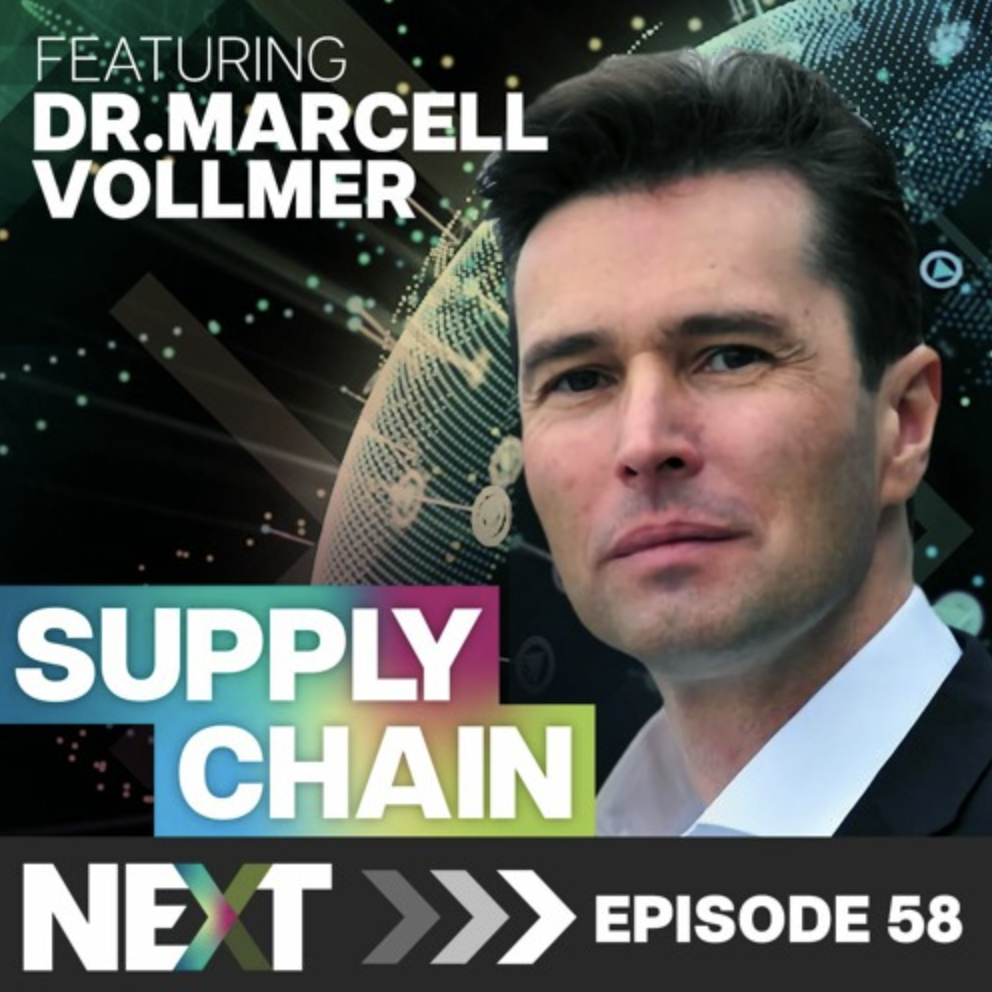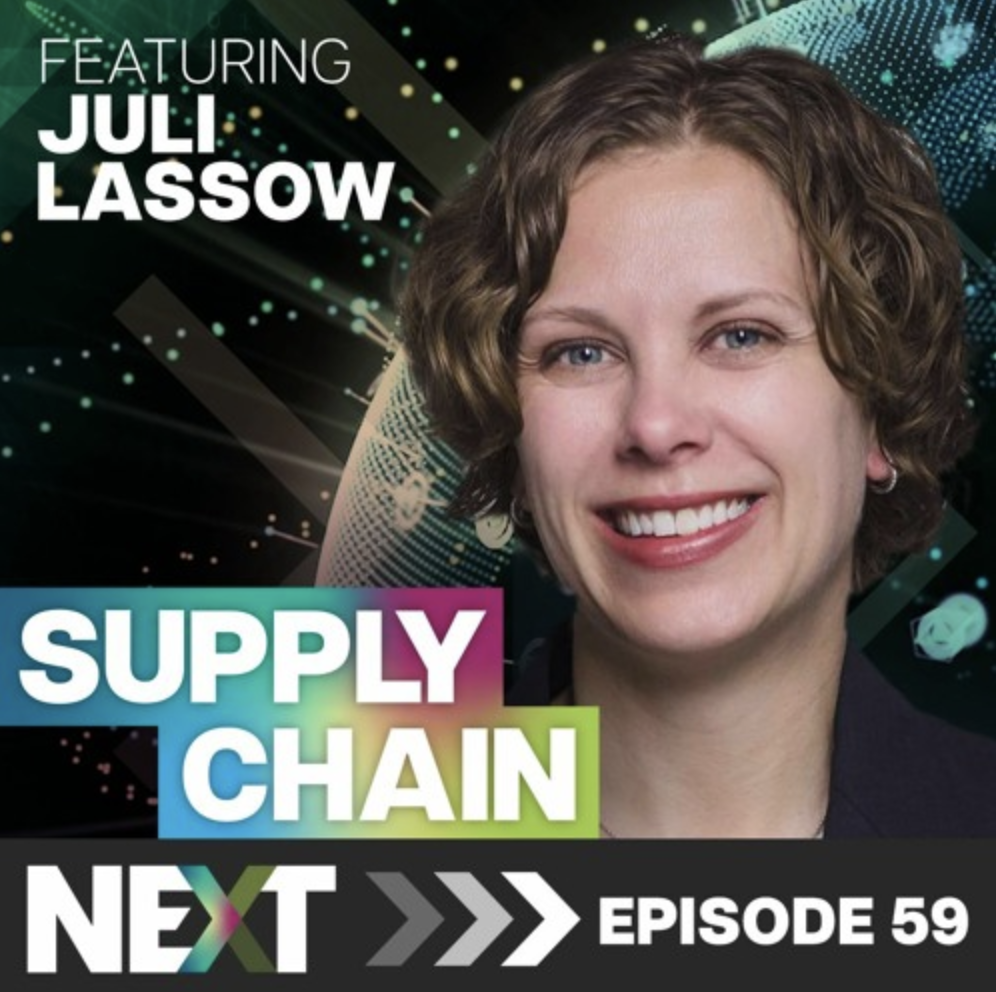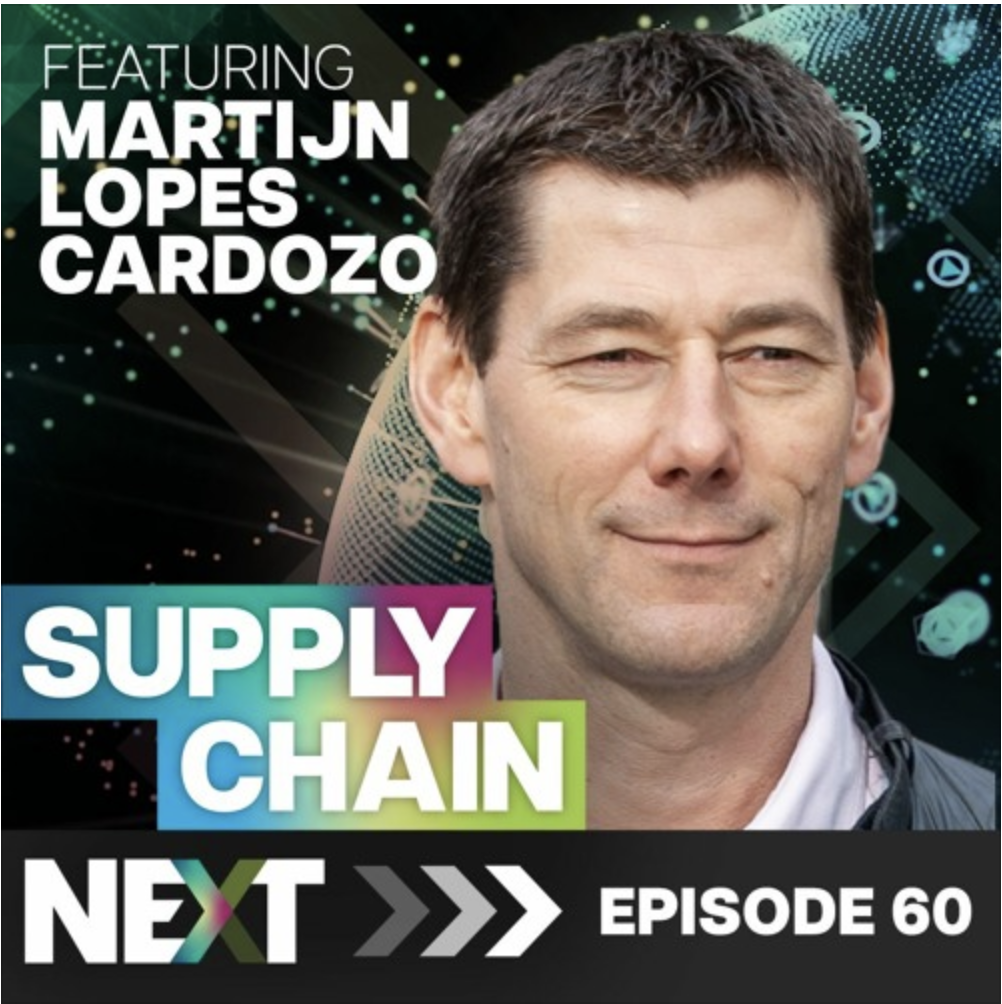EPISODE 27
Podcast: Bram Desmet on Aligning Supply Chains with Business Strategy
Bram Desmet specializes in advanced analytics, supply chain models, and strategy. His gift for numbers, figures, and statistics led him to study mathematics at university. On a quest to put his fascination to use, he decided to combine his mathematics—and later his MBA education—to pursue inventory modelling.
With his 20+ years of industry experience Bram founded Solventure Group to help companies align their daily operations with their business goals. He has also written two books: Supply Chain Strategy and Financial Metrics and the soon-to-be-published The Strategy-Driven Supply Chain available in May 2021.
Bram is also a professor at Vlerick Business School and Peking University where he teaches supply chain strategy.
On episode 27 of Supply Chain Next, Bram talks with Richard Donaldson about how to start from the right place: designing your business plan and daily operations around the most critical component—your supply chain.
Listen to the podcast below or watch the video version on YouTube.

Highlights from the Conversation
As per tradition I want to ask, “who are you Bram? And how did you get into supply chain… coming from mathematics?”
- In 1998 I graduated from a mathematics program.
- Since it was close to the year 2000, the world was screaming for information technology (IT) people. I actually started my career in IT but I left after 5 years. IT was interesting but it was more of a means to an end for me, not a goal.
- I was pursuing an executive MBA program at the time from a business school, where I’m currently teaching.
Supply chain is quite interesting so I went down that road. I did a PhD in inventory modelling, which is very quantitative. It’s also at a crossroads (between mathematics and business). - Take a process like sales and operations planning (S&OP). It’s between sales, finance, operations, product management, and marketing. This was fitting well with the MBA program I was doing.
- In the end, if you want to move something in supply chain sooner or later you hit IT systems.
- I wasn’t born as a supply chain person but it combines several fields that coincided with my studies and experience so it seemed the logical choice.
- I began to do consulting. This led to me becoming a professor at Vlerick Business School.
- In about 2009 I became responsible for Solventure which was a part of a larger consulting group. Solventure is in the S&OP consultation space focused on process, people, tools, and analytics. I did a management buyout of Solventure in 2016.
- My PhD brought me to the Vlerick Business School where I currently teach supply chain principles.
- After 20 years in the field I decided it was time to share my experience in the field and so I wrote my first book Supply Chain Strategy and Financial Metrics.
- I then wanted to write more about what I had learned in the industry and so that led me to write my second book The Strategy-Driven Supply Chain (due out in May 2021).
IT is an interesting place to start from. There’s a lack of advanced IT in the area of supply chain. If you look at supply chain now it’s like it’s stuck in the 1970s.
What did the technology look like when you entered supply chain?
- The IT within supply chain is an area which is heavily underinvested.
- Companies spend a huge amount of money on enterprise resource planning (ERP) systems. The cost of these ERP systems, including migrating from one version to another, is easily ten times the cost of getting a good supply chain platform. ERP can’t handle supply chain operations very effectively.
- Supply chain systems have a direct effect on metrics: service, cost, etc.
- The business case for a specialized supply chain system is much better than a business case for an ERP system. We still invest in ERP because we “have to”, it’s almost mandatory.
- The importance of supply chain is poorly understood. Executives would rather invest in another assembly line than invest in a proper supply chain system.
- If we really want to create value in supply chain we have to rewire people’s brains. Software isn’t enough.
- I often tell people that if they want their executives to understand their supply chain, the best thing to do is not talk about supply chain, because the moment you start talking about it they start sweating. You need to talk business language with executives since it is what they understand. I tell them that they have to match their supply chain structure to their business goals and to be prepared to invest in the proper systems and processes.
- I will tell them about the Triangle (service, cost, and cash) from my book.
ERP systems, for better or for worse, have always been conflated with supply chain. I believe that ERP systems were never trying to solve supply chain issues.
How do you see ERPs in relation to supply chain? And how do supply chain platforms resolve the needs of your Triangle?
- There are two views generally taken when looking at supply chain. The first is the process-oriented view. This is what ERP systems fall under.
- The second is the balanced perspective. This is where you must consider that moving one part of the supply chain will necessarily move another connected part.
- The Triangle is about the balanced view of supply chain. If you don’t manage every metric of the Triangle you will get conflicts in your operations.
- ERP systems are very transactional. They look at today and tomorrow but not the next three or 12 months.
- Supply chain systems need to look much further into the future than they currently do. A long-term view is essential.
- The ability to foresee the outcome of certain decisions would be highly valuable within a supply chain system. For example, we should be able to see what would happen if we adjust inventory at any given point. What would the outcome be?
- We need to be able to run test scenarios as well as having access to optimization features within the supply chain systems. If we could run scenarios within the system it would save executives the need to visualize how certain decisions play out.
- Supply chain systems will begin to move into the direction of autonomy and more predictive value.
Can we talk about your Triangle? How did you come up with your way of viewing the metrics of service, cost, and cash, and how do those metrics lead to optimizing return on investment (ROI)?
- It really comes out of practical experience. In the beginning of my consultation career I did a lot of inventory optimization projects. In the Triangle I come from the inventory angle (the cash metric).
- It was a way for me to summarize how I saw companies struggle. They would start, let’s say, 10 projects aimed at optimizing their operations. As the year progressed only three projects would be left. Then the projects would fizzle out and they would resort to lowering their safety stock to save cash. They would then get service issues all over the place, which would cause a chain reaction into other areas of the operations.
- I’ve seen so many companies struggling in so many ways. Mainly around getting a grip on inventories. These challenges cannot be solved by supply chain alone.
- The people in sales inflate the forecast because they don’t want to admit they won’t hit their targets. Product managers are increasing their new product like crazy but they’re not cleaning up their old stock. Purchasing is making agreements with suppliers to reduce the costs but making promises on volume commitments, which increases inventory again. Every metric has an impact on inventory.
- Everybody in the company blames the supply chain and doesn’t let their own departments take any blame for the unoptimized operations as a whole.
- This is where I tried to explain the wholistic approach of the Triangle in my book. Each metric of the Triangle is interconnected with the others (service, cost, and cash).
- The first thing I used the Triangle for was to bring different people from different departments together: sales people, supply chain people, finance people… so I could show them the interconnected nature of the Triangle and that each metric needs to be manipulated with the other metrics in mind.
So, in summary, you’ve got service, cost, and cash as the three parts of the Triangle, and this is a great way to look at the various pieces.
It would seem to me that assets are the key element within supply chain. The return on investments can be tracked down to the assets. This is the lowest common denominator in supply chain. What do you think of this viewpoint?
- It’s all about the return on investment and the strategies that get you there.
- For example, a low-cost airline typically works with low margins. How do they do this? They are very efficient. One of the smaller airlines here in Europe only has only one type of plane so they can really control their margins.
- If you want to be a full service player, like a major airline, you will need many more types of planes and will require more assets. You will also have bigger margins that require a greater ROI.
- It all comes down to what kind of supply chain you want to be. Do you want to be a low-cost, high-efficiency supply chain? Or another type? I say it doesn’t matter which one you choose as long as the ROI is there.
- For supply chain it’s all about the capital employed and the margins. These must be properly balanced so the different departments in the company aren’t conflicting with each other. This makes supply chain really strategic.
To use your example of airlines, the lowest common denominator “unit” is the “passenger seat mile”—the capital it takes to create and maintain that seat in order to sell it to a customer.
- The margin per seat will be much higher in bigger airlines but so is the initial investment and cost to keep that seat in the air.
- There is no “one size fits all” within supply chain. The supply chain must be tailored to the value proposition and ROI.
- This comes down to the units used within the supply chain, such as the “seat-mile” unit of the airline example.
Your Triangle model is high level but if we drill down into each of the metrics, what is the core unit of each?
- There is the thinking that a good supply chain is cost-effective but I have discovered otherwise.
- If I want to get to the lowest cost possible (in each metric of the Triangle) I need to reduce complexity.
- Whether you have a simple or a complex portfolio, the main question is the same: what margin are you operating at and what was your initial investment?
- If a customer is willing to pay a premium then it’s OK to have higher operating costs to produce a premium product or service.
- The supply chain must fit the business needs based on the needs of the target market.
- I discuss this in my second book, the link between what you want to put into the market and the supply chain it takes to get there. This is strategy-driven supply chain thinking.
- If somebody wants to be a high-end niche player, they will most likely have more complex products, and this requires a more complex supply chain. So this must be considered when planning operations.
- As long as your business strategy has more complexity, your supply chain will become more costly.
- I did a lot of work with a big retailer here in Belgium. They had many different business units and each one was focused on a different goal.
- This experience showed me that the company as a whole must be on the same page with regards to their overall strategy for their operations.
Your first book laid down the technical aspects of supply chain. And now, your second book is tackling the strategic aspects.
How fundamental is the strategy of the supply chain to the success of the business?
- Over the last three years my experience has taught me that most companies lack a good strategy when it comes to their supply chain.
- Successful companies make very clear and deliberate choices. Think of a company like Apple. When I started working in 1998 Apple was virtually bankrupt. Then they brought Steve Jobs back and 20 years later they are one of the most successful companies in the world. How did they do this? They accomplished this by introducing a continuous stream of innovations, not by constantly inventing new products.
- I have found that companies are bad at making choices. For example, I see companies that try to combine private label and branded products. Private labels are all about efficiency and lowest cost. Branded is about innovation. You cannot combine Apple and Walmart. This happens when a branding company tries to get into a higher market. It’s just not that simple.
- Premium brands start out at the beginning with a supply chain designed to produce premium products and services.
- When a “lower” brand tries to enter the “higher” marketplace they find that they are not prepared.
- The company needs to know who they are. This helps them to form their central strategy concerning their supply chain operations.
- You cannot start out with a business strategy and then convert it into a supply chain strategy. This isn’t how it works.
- Apple’s supply chain was specifically designed for the output of premium products and services. That’s why it works the way it does, that’s why it produces the results they need to continue their output.
- If you are driven by innovation you need flexible supply chains. Apple has done this by outsourcing to Foxconn. Don’t compare yourself to Apple. There is only one Apple.
- If you want the same flexibility of supply chain, the way Apple has done it, then you need to be able to gracefully react to change within your supply chain. This of course results in more costly operations.
- So we need to stop saying, “First we find a business strategy, then we’ll work on our supply chain strategy.” This won’t work. They are two sides of the same coin. Without the costs upfront you have no business plan.
- There is no supply chain strategy, only a business strategy. And in the business strategy you have to know who you want to be to your target customers. What is your value proposition?
- Instead of talking about supply chain strategy I talk about business strategy. The value proposition and the supply chain are the corresponding sides of the coin. They need each other.
- You should not accept a business strategy defined by your sales department because they usually don’t know the whole picture. A business strategy is only complete when it includes the supply chain at its core.
- Is the value proposition and market definition clear and sharp? The supply chain must match the value proposition. Only then can I design a proper supply chain. This is one of the key themes in my new book.
Everybody in the world now realizes how important supply chain is now, thanks to the pandemic.
Every individual is part of the aggregate supply chain and people are waking up to this.
This has helped to make supply chain synonymous to business strategy. They have to be in synch with each other.
When I look at the capital employed and the return on that capital, what is the time it takes to get to the profits from the initial investment?
- One of the metrics I explain in my book is the cash conversion cycle. In Europe we can defer payment to our suppliers for materials. This means that (in certain situations where stock moves fast, like in a food store) the customer has paid for the goods before the supplier is paid.
- The cost of capital is different depending on the company.
Where do you see sustainability playing out in all of this? How do we get the issue of sustainability to default status when creating new business plans? How do we bring sustainability into existing operations?
- Sustainability is unfortunately in conflict with the Triangle in certain companies. For example, if a company chooses to reduce carbon by shipping their goods on a boat instead of a plane, the cost goes down, but to increase efficiency of the boat trip it is better to increase volume. Now extra goods are coming in and the need for more storage capacity rises.
- If sustainability negatively impacts the finance metrics I don’t think many will adopt it. Sustainability is just another metric that needs consideration.
- There are many people who will not buy from you unless you meet a certain level of sustainability and people are willing to pay more for a product or service that was brought to them by sustainable methods.
- When more consumers choose to buy based on sustainability it will force circularity across all industries.
It’s OK to have more expensive supply chains in operation if the consumer is willing to pay the premium.
Sustainability is a growing factor and is becoming more important. Eventually nobody will be able to run their operations without the public knowledge that they are sustainable in their business practices. - Businesses will use sustainability to get ahead in their markets by targeting customers who want their consumer goods produced with sustainable methods. Just like how consumers are willing to pay for a premium product, they are also willing to pay more for a sustainable product. This will eventually force circularity across the board.
- Once a company knows its value proposition, only then can it design its supply chain. Some businesses will have different value propositions ranging from profit to circularity.
Connect with Bram Desmet
Bram is ready to connect on LinkedIn.
More Episodes
You can listen to our audio tracks and read highlights for each episode below.
We’ve also started publishing video episodes on our YouTube channel.
058 – Dr Marcell Vollmer – Tech in Supply Chain, and the Sustainability Shift
Supply Chain Next · 058 – Dr Marcell Vollmer – Tech in Supply Chain, and the Sustainability Shift Meet Dr. Marcell Vollmer Dr. Marcell Vollmer, a renowned expert in the fields of digitalization, innovation, and sustainability. Marcell is a sought-after speaker and author that has dedicated his career to helping companies and individuals navigate the rapidly…
059 – Juli Lassow – Revolutionizing Retail, Sustainable Strategies, & the Future of Partnerships
Supply Chain Next · 059 – Juli Lassow – Revolutionizing Retail, Sustainable Strategies, & the Future of Partnerships Juli Lassow ,founder of JHL Solutions Meet Juli Lassow Juli Lassow, an accomplished retail professional, speaker, writer, and sustainability advocate, is the founder of JHL Solutions, a consultancy focused on creating outstanding private-label partnerships. With a deep…
060 – Martijn Lopes Cardozo – Circular Supply Chain
Supply Chain Next · 060 – Martijn Lopes Cardozo – Circular Supply Chain Martijn Lopes Cardozo, CEO at Circle Economy Meet Martijn Lopes Cardozo Martijn, a seasoned entrepreneur, has an impressive track record of establishing prosperous ventures within the realms of software, mobile, and digital media in California. Upon returning to the Netherlands, he…



